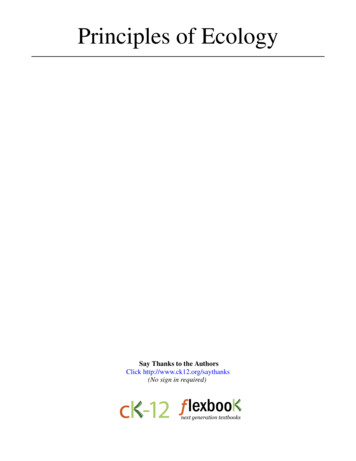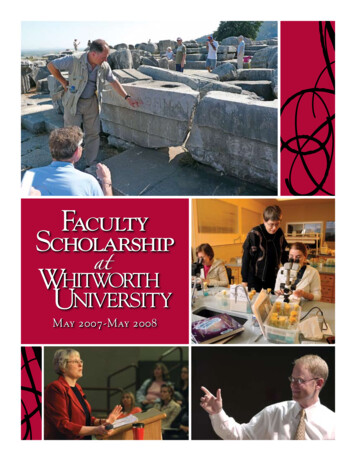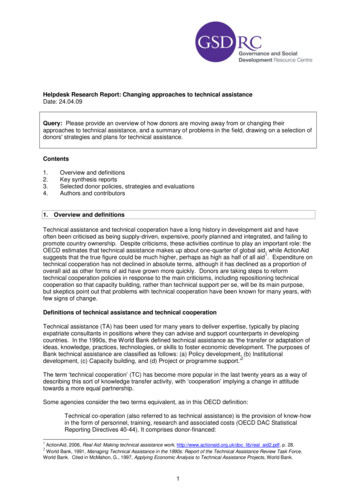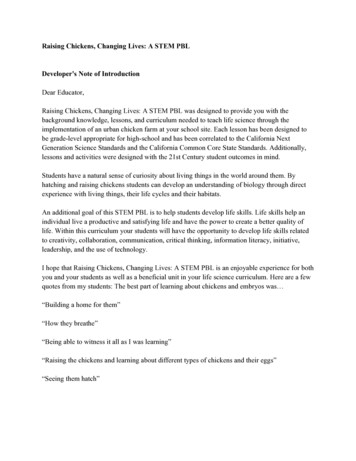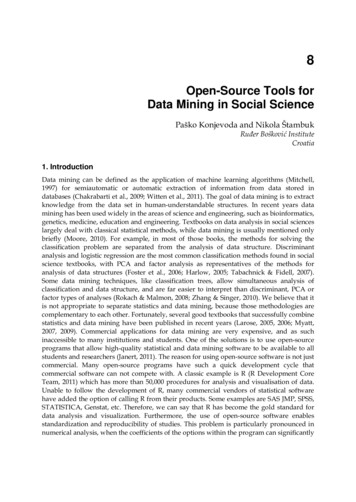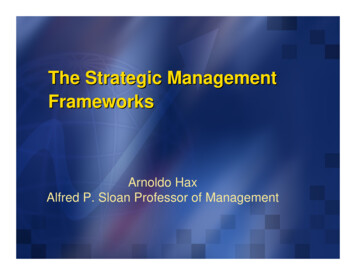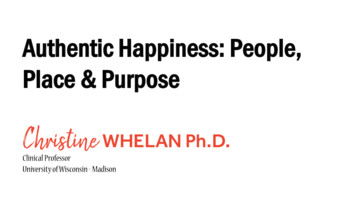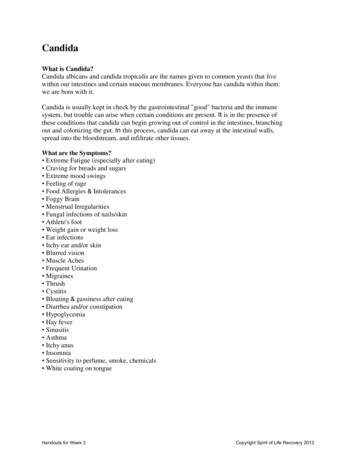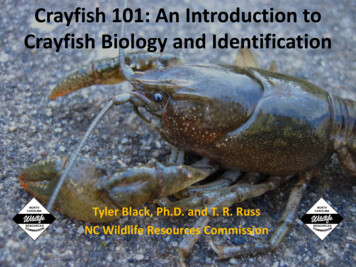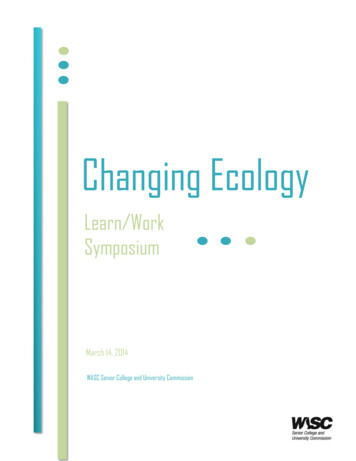
Transcription
Changing EcologyLearn/WorkSymposiumMarch 14, 2014WASC Senior College and University Commission
Table of ContentsContext Statement .3Agenda .5List of Participants .7Track One—Emerging Business Models .9Overview .11Panelist Context Statements .15Supplemental Readings Meet the New For-Profit: The Low-Profit, Goldie Blumenstyk,Chronicle of Higher Education, October 14, 2012 .35 For-Profit College Becomes a 'Public-Benefit Corporation', Chronicle of Higher Education,January 23, 2014 .39 Saybrook joins growing nonprofit education system, a possible new modelfor higher ed, Inside Higher Ed, October 10, 2013 .42 Money, Politics and the Rise of For-Profit Higher Education in the US: A Story of Supply,Demand and the Brazilian Effect, John Aubrey Douglass, UC Berkeley, February 2012 .45Related WASC Policies Appropriate Level of Review of Proposed Changes in Mission, Legal Status, Ownershipor Control Policy .63 Independent Governing Board Policy .66 Institutions within a System Policy .78 Related Entities Policy .80 Quick Reference Guide to WASC Standards (CFRs 1.5 and 3.9 and related policies).81Panelist Bios .99Track Two—Contracts with Unaccredited Organizations . 103Overview . 105Panelist Context Statements . 111Supplemental Readings Going the Distance: Outsourcing Online Learning, Susan E. Metros and Joan Getman,from Game Changers, EDUCAUSE Publications, 2012. 123 No College Left Behind: Randy Best's Money-Making Mission To Save Higher Education,Forbes Magazine, February 12, 2014 . 148 Spectrum of University Functions Managed by Vendors, The Parthenon Group,January 2014 . 154 US Code of Federal Regulations: §602.22 Substantive Change . 155Related WASC Policies Contracts with Unaccredited Organizations Policy—REVISED DRAFT . 159 Outsourcing Services to Unaccredited Organizations—DRAFT . 161 Quick Reference Guide to WASC Standards (CFR 2.4) . 163Panelist Bios . 181WASC Changing Ecology Learn/Work Symposium1
WASC Changing Ecology Learn/Work Symposium2
Context StatementAccreditation decisions are very much about institutions. The WASC standards expect institutions tohave education as their primary purpose and to operate with appropriate autonomy as an academicinstitution (CFR 1.5). This entails that the institution maintain financial stability and long-term viability(CFR 3.4) and that its executive officers provide effective educational leadership and management (CFR3.8), its governing board is sufficiently independent to oversee its integrity (CFR 3.9), and its facultyexercises leadership to ensure academic quality (CFR 3.10). Increasingly, institutions are makingstructural changes and entering into a variety of agreements with other organizations to improve theireffectiveness or their prospects for sustainability.Institutions within the WASC region are diverse, differing widely in their educational missions,structures, relationships, and financial situations. To honor this diversity, reviewers apply the WASCStandards and Criteria For Review in the context of an institution’s mission, character, and type. To dothis well, we need to educate ourselves about the legal and financial frameworks within whicheducational institutions can operate. We also need to review some WASC policies and practices toensure that they help rather than hinder institutions making changes in pursuit of their corecommitment to institutional integrity, sustainability, and accountability while still assuring compliancewith the Standards.Today’s program is divided into two tracks, both of which explore institutional changes and relationshipsthat affect an institution’s capacity and educational effectiveness. Track 1 focuses on changes inbusiness model, ownership, mission, or control. Track 2 focuses on contracts or partnerships withunaccredited organizations or vendors to provide institutional support, student services, or instructionalresources. The day begins with presentations from invited panel members and concludes with facilitateddiscussion and review of several WASC policies in light of what we learn.WASC Changing Ecology Learn/Work Symposium3
WASC Changing Ecology Learn/Work Symposium4
WASC Changing Ecology Learn/Work SymposiumFriday, March 14, 2014Agenda9:00-9:45amWelcome – Mary Ellen PetriskoOverview of Agenda – Melanie BoothIntroductions—Sharyl McGrewContext and Framework – Bill Ladusaw9:45-10:00amBreak10:00am – 12:00pmTrack Groups: Expert panels (approximately 1 hour)Facilitated discussion of issues / questions emerging from thepanel (approximately 1 hour)12:00 – 1:00pmLunch1:00-1:15pmLarge group morning debrief—Bill Ladusaw and Margaret Kasimatis1:15 – 3:45pmTrack Groups: 3:45 – 5:00pmContinue to explore topic together – implications for WASC, subchange, institutions, etc.Begin work on track’s identified end productBreak at 2:15Report out from each track—Bill Ladusaw and Margaret KasimatisSynthesis and Next Steps—Mary Ellen PetriskoWASC Changing Ecology Learn/Work Symposium5
WASC Changing Ecology Learn/Work Symposium6
List of ParticipantsMaggie Bailey, Vice Provost for Program Development and ALO, Point Loma Nazarene University,Substantive Change Committee memberBrenda Barham Hill, WASC Associate, former CEO, Claremont University Consortium (retired)Melanie Booth, Vice President, WASCGary Brahm, Chancellor, Brandman UniversityLinda Buckley, Associate Vice President Academic Planning and Educational Effectiveness, San FranciscoState UniversityRonald L. Carter, Provost and Professor of Biology, Loma Linda University, WASC CommissionerPhilip Clayton, Professor of Theology, Claremont School of Theology, former Executive Vice Presidentand Provost of Claremont Lincoln University, Substantive Change Committee memberBarbara Gross Davis, Vice President, WASCGreg Dewey, President, Albany College of Pharmacy and Health Sciences (ACPHS) (effective July 1,2014), Substantive Change Committee memberDenise DeZolt, Chief Academic Officer, Global Products and Services, Laureate EducationKai Drekmeier, Founder and President, Inside TrackChristopher Etesse, Chief Executive Officer, Flat World KnowledgeDavid Figuli, Managing Director, University VenturesRich Goldberg, Managing Director, Pearson EmbanetMichael Horowitz, Chief Executive Officer, TCS Education SystemFran Horvath, Associate Provost for Educational Effectiveness, Naval Postgraduate School, SubstantiveChange Committee co-chairDennis Jaehne, Acting Deputy Provost and Associate Vice President for Undergraduate Studies, San JoseState University, WASC Interim Report Committee memberRuki Jayaraman, Vice Chancellor of Academic Affair, Argosy University system, Substantive ChangeCommittee memberWASC Changing Ecology Learn/Work Symposium7WASC Changing Ecology Learn/Work Symposium7
Barbara Karlin, Vice President of Academic Affairs, Golden Gate University, WASC CommissionerMargaret Kasimatis, Associate Provost for Strategic Planning & Educational Effectiveness, LoyolaMarymount University, WASC CommissionerWilliam A. Ladusaw, Dean of Humanities and Professor of Linguistics, UC Santa Cruz, Vice Chair of theWASC CommissionMaureen Maloney, Vice President, WASCSharyl McGrew, Director of Substantive Change and Committee Relations, WASCSusan Metros, Associate Chief Information Officer, University of Southern CaliforniaPatty Mullen, Associate Provost for Institutional Research, Alliant International University, SubstantiveChange Committee memberChristopher Oberg, Vice President, WASCRichard Osborn, Vice President, WASCMary Ellen Petrisko, President and Executive Director, WASCJohn Przypyszny, Partner, Drinker Biddle & Reath LLPSharon Salinger, Dean of Undergraduate Education and Professor of History, University of California,Irvine, WASC CommissionerElise Scanlon, Principal, Elise Scanlon Law GroupMark Schulman, President, Saybrook UniversityThomas Stewart, President, Patten UniversityCynthia Teniente-Matson, Vice President for Administration and Chief Financial Officer, Fresno StateUniversity, Substantive Change Committee memberSteve Varvis, Provost, Fresno Pacific University, Substantive Change Committee memberRichard Winn, Executive Vice President, WASCWASC Changing Ecology Learn/Work Symposium8WASC Changing Ecology Learn/Work Symposium8
Track One:Emerging Business ModelsWASC Changing Ecology Learn/Work Symposium9
WASC Changing Ecology Learn/Work Symposium10
Track One – Emerging Business ModelsCONTEXTIn recent years, WASC has seen a significant shift in the organizational structures of institutions of highereducation. The number of WASC‐accredited for‐profit institutions has increased 600% since 2007, asinstitutions have moved to the WASC region, converted from nonprofit to for‐profit status, or soughtWASC accreditation for the first time. Nonprofit institutions are dealing with persistent financialchallenges by converting to for‐profits, joining nonprofit systems or merging with each other to leverageshared services, or more recently, by contemplating conversion to benefit corporation status, whichallows shareholders to make a profit while requiring the institution to be held accountable to performsome public good.Since 2007: Five institutions have converted from nonprofit to for‐profit status, with another one pending. The number of for‐profit institutions accredited by WASC has grown from three to 18, with 11more in the Eligibility pipeline. Of the 20 Eligible institutions currently seeking WASCaccreditation, 55% are for‐profit. Three standalone nonprofit institutions have become part of a nonprofit system. The first conversion of a nonprofit institution to a benefit corporation in the WASC region ispending review this spring. Nine (and one pending) institutions have merged with each other or acquired institutions notpreviously accredited by the agency.This session will explore the opportunities and challenges inherent in this dynamic environment andexamine the role that WASC might play to support its member institutions as they navigate thesechanges.PARTICIPANTSPanel Facilitator Christopher Oberg, Vice President, WASCPanel Members John Przypyszny, Partner, Drinker Biddle & Reath LLP David Figuli, Managing Director, University Ventures Michael Horowitz, Chief Executive Officer, TCS Education System Denise DeZolt, Chief Academic Officer, Global Products and Services, Laureate Education Thomas Stewart, President, Patten University Mark Schulman, President, Saybrook UniversityAfternoon Session Facilitator Bill Ladusaw, Dean of Humanities, UC Santa Cruz and Vice Chair, WASC CommissionWorkgroup Members Margaret Bailey, Vice Provost and WASC ALO, Point Loma Nazarene University, SubstantiveChange Committee memberWASC Changing Ecology Learn/Work Symposium11WASC Changing Ecology Learn/Work Symposium11
Linda Buckley, Associate Vice President Academic Planning and Educational Effectiveness, SanFrancisco State University, WASC CommissionerGreg Dewey, President Elect, Albany College of Pharmacy and Health Sciences, SubstantiveChange Committee memberBarbara Gross Davis, Vice President, WASCFran Horvath, Associate Provost for Educational Effectiveness, Naval Postgraduate School,Substantive Change Committee co‐chairBarbara Karlin, Vice President for Academic Affairs, Golden Gate University, WASCCommissionerMary Ellen Petrisko, President and Executive Director, WASCCynthia Teniente‐Matson, Vice President for Administration and Chief Financial Officer, CSUFresno, Substantive Change Committee memberSteve Varvis, Provost, Fresno Pacific University, Substantive Change Committee memberRichard Winn, Executive Vice President, WASCStaff Support Melanie Booth, Vice President, WASCPANELIST CONTEXT STATEMENTSSUPPLEMENTAL READINGS Meet the New For‐Profit: The Low‐Profit, Goldie Blumenstyk, Chronicle of Higher Education,October 14, 2012 Saybrook joins growing nonprofit education system, a possible new model for higher ed, InsideHigher Ed, October 10, 2013 For‐Profit College Becomes a 'Public‐Benefit Corporation', Chronicle of Higher Education,January 23, 2014 Money, Politics and the Rise of For‐Profit Higher Education in the US: A Story of Supply, Demandand the Brazilian Effect, John Aubrey Douglass, UC Berkeley, February 2012RELATED WASC POLICIES Appropriate Level of Review of Proposed Changes in Mission, Legal Status, Ownership or ControlPolicy Independent Governing Board Policy Institutions within a System Policy Related Entities Policy Quick Reference Guide to WASC Standards (CFRs 1.5 and 3.9 and related policies)PANELIST BIOSAREAS OF INQUIRY/NEEDS What do we think are the most critical issues related to these emerging issues from the panelpresentations? What are the benefits/opportunities of these emerging models/associated with these issues? What are the concerns/threats for a regional accreditor and the region to consider? What might WASC’s position be on these emerging models: the benefit corporation, the NPsystem, conversions, and other emerging models?WASC Changing Ecology Learn/Work Symposium12WASC Changing Ecology Learn/Work Symposium12
What role does WASC play in this larger ecosystem?How do we support /respond to the changing business models for some of our institutions?What are the policy implications?What are the needed resources? (e.g., for substantive change reviewers; for the Commission;for institutions?)What additional information do we need now or should we be on the lookout for?WASC Changing Ecology Learn/Work Symposium13WASC Changing Ecology Learn/Work Symposium13
WASC Changing Ecology Learn/Work Symposium14
Track One:Panelist Context StatementsWASC Changing Ecology Learn/Work Symposium14WASC Changing Ecology Learn/Work Symposium15
WASC Changing Ecology Learn/Work Symposium16
EMERGING BUSINESS MODELSDiscussion with the Senior College and University Commission of theWestern Association of Colleges and SchoolsJohn R. PrzypysznyDrinker Biddle & Reath LLPMarch 14, 2014OverviewIncreasingly, both for-profit and non-profit institutions are considering new business andoperational models, both as a means of enhancing innovative educational delivery methods, anddue to the perceived economic benefits. In some cases these models involve changes of control,mission, or structure, in other cases the changes are more subtle and have little impact on theoperations of the institution and may not require regulatory approval.The emerging models that I will focus on for purposes of my discussion are (1)conversion of non-profit to for profit institution; (2) minority non-controlling investments in forprofit institutions; (3) the rise of the benefit corporation; and (4) the joint venture model.1.Conversions of non-profit institutions to for-profit institutionsConversions of non-profit to for-profit institutions are becoming increasingly common.The reasons for such conversions vary, but are likely the result of an increasing number ofstruggling non-profit institutions seeking for-profit partners in an effort to ensure that theinstitution has future viability. In addition, smaller non-profit institutions often have limitedresources at their disposal to add programs or locations, or to develop distance educationplatforms; thus, an acquisition by a for-profit partner may allow it to increase its programofferings or provide other strategic benefits, often with the goal of improving the institution’sfinances.Conversions typically involve the sale of all of the assets of the institution to a for-profitinvestor or institution. The non-profit institution becomes a non-profit foundation and thefoundation then receives the proceeds of the sale, and retains any assets that must remain in anon-profit entity, such as certain bequests. The proceeds must then be used the non-profitfoundation for purposes that further its non-profit or charitable mission. Typically, this mightinclude providing scholarships or even educational research activities. There also have beeninstances where the non-profit foundation obtains a small ownership interest in the for-profitinstitution as part of the consideration for the transaction. That can help provide some measureof continuity, while also providing the non-profit foundation with an ability to continue to sharein the proceeds in the institution going forward.In many ways, a conversion of a non-profit to a for-profit institution is no different thanany other sale of an institution. There is an asset purchase agreement and approvals must beobtained not only from the regional accreditor, but from the state educational authorities thatauthorize the institution (unless exempt from licensure, such as is the case in California), as wellWASC Changing Ecology Learn/Work Symposium17
as from the U.S. Department of Education (“USDOE”) for continued participation in federalstudent aid programs.An important distinction is that that in many states the state attorney general (“AG”) mustreview and some cases approve the transaction, in a fiduciary capacity, to ensure that the sale isat arms length and at fair market value, and that self-dealing is not involved. California is onethe states where the AG must provide an affirmative acquiescence to the transaction before it canoccur. Typically, the USDOE asks to see a copy of the AG approval as well.Often, the converted entity takes the form of a limited liability co
Changing Ecology Learn/Work Symposium March 14, 2014 WASC
